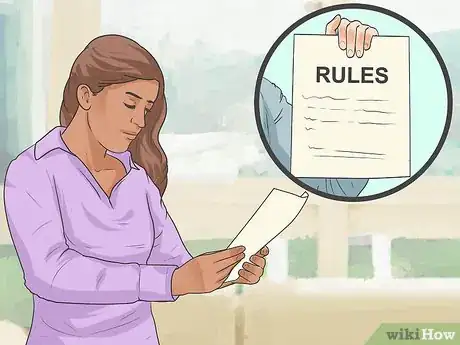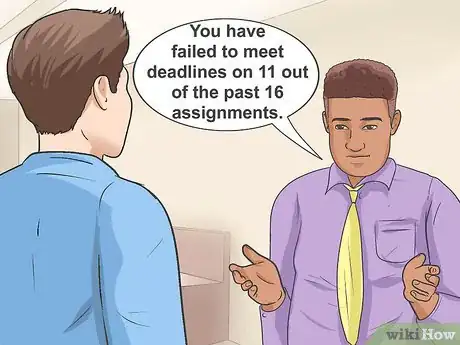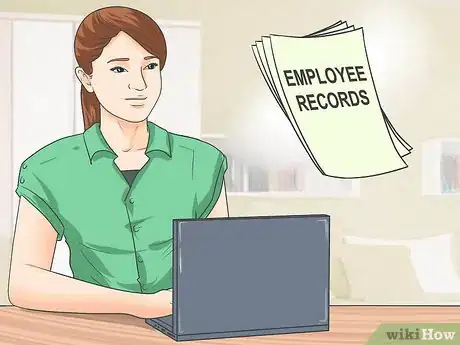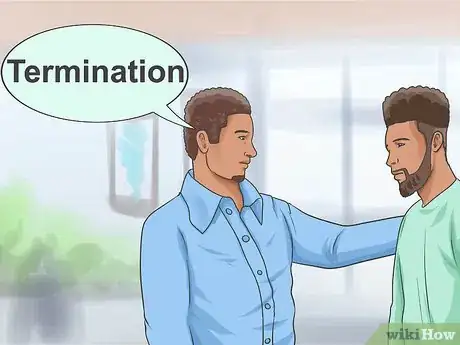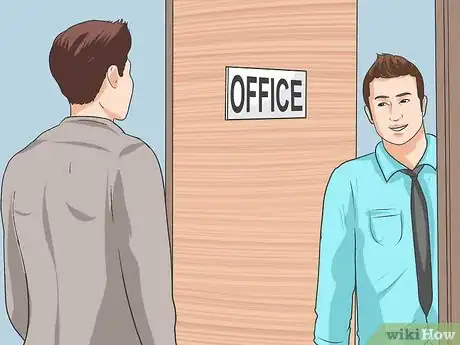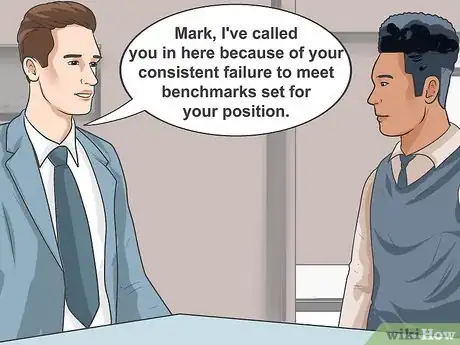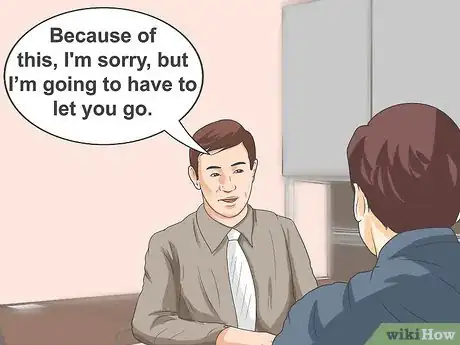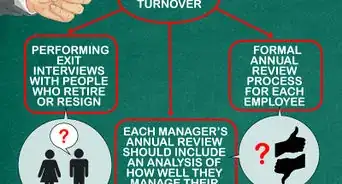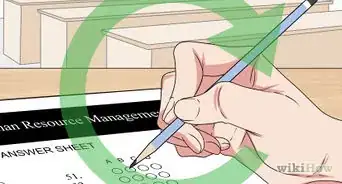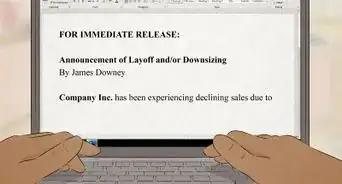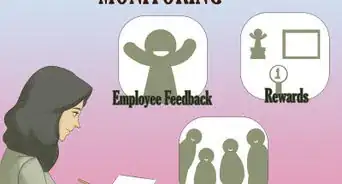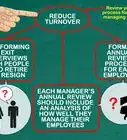This article was co-authored by Madison Boehm. Madison Boehm is a Business Advisor and the Co-Founder of Jaxson Maximus, a men’s salon and custom clothiers based in southern Florida. She specializes in business development, operations, and finance. Additionally, she has experience in the salon, clothing, and retail sectors. Madison holds a BBA in Entrepreneurship and Marketing from The University of Houston.
There are 8 references cited in this article, which can be found at the bottom of the page.
wikiHow marks an article as reader-approved once it receives enough positive feedback. In this case, several readers have written to tell us that this article was helpful to them, earning it our reader-approved status.
This article has been viewed 472,149 times.
If you have a problem with an employee, you have not one but two choices: try to coach them and work with them to improve their performance, or fire them. Firing an employee can be costly and cause your employee a great deal of emotional and financial difficulties—especially in the modern economy. Done in the wrong way, firing someone can also open you or your organization up to liability and lawsuits. Unfortunately, however, there are situations where terminating an employee is your only option. This article will show you how to fire somebody gracefully and safely.
Steps
Before the Termination
-
1Set Expectations. Discuss with your employees any behavior that could be grounds for immediate termination.[1]
- Don't wait until behavior is already occurring. Be sure that all employees understand the rules and productivity expectations up front. These might include such things as failing to disclose arrest records, lying about past employment, failing a drug test, insubordination, excessive absence—and what constitutes “excessive”—and other issues that affect job performance.
-
2Give regular performance appraisals. It is best to have the right person for each position.[2] Evaluate employee work at least once a year and document deficiencies in performance versus your expectations or the actual job requirements. When an employee comes up short, discuss ways to improve and give the employee clear steps and goals to help them improve.[3]Advertisement
-
3Be sure of your standing. Unless you are the company owner, know your employer's rules about firing someone.
- There may be specific steps you are required to take to fire someone -- even if the employee is not doing their job. Never undermine your employer and risk your own position by taking such actions without informing your own supervisor.
-
4Act quickly when problems are noticed. Be sure to communicate performance problems as soon as you are aware of them, and coach your employee on how to improve.[4]
- Sit down with your employee and discuss with them the problem. Ask them what they think is causing their performance to be substandard, and and offer suggestions for their improvement.
- Keep a written record of these conversations. Either have them sign a form that covers what was discussed, or send them a formal email, or both. If sending an email, ask your employee to reply to it when they’ve read it, both to acknowledge receipt and to give them an opportunity to respond in writing.
-
5Consider personal factors. While companies have to keep an eye on their productivity, workplace environment and bottom line, it's wise to ask about and consider any extraneous circumstances in your employee's life that may temporarily be effecting their performance. Health problems, death/illness in the family, pregnancy, divorce or other relationship trauma, moving stress, and financial troubles are all part of life and can understandably cause otherwise valuable employees to lose focus. However these drops in productivity can be temporary, and firing someone in the midst of outside difficulties can be cruel and potentially bring bad publicity to your organization. If possible, consider giving the employee some consideration and an opportunity to resolve their difficulties so their performance can improve.[5]
-
6Focus on the problem. When you counsel an employee, focus on the facts, without editorial comment. "You have failed to meet deadlines on 11 out of the past 16 assignments" is appropriate. "You're slacking off" is inappropriate.
-
7Keep records. Should the need arise, you want to have a paper trail that shows you were neither capricious nor arbitrary in your decision to serve the termination letter. [6]
- Retain a record of all disciplinary actions. Have the employee sign some sort of document outlining the conversation to cover yourself and the company. It should specifically state that the employee is not admitting fault, but has been told that job performance is not satisfactory.
- Outline specific improvements or changes required in order for them to keep their job, and give them clear deadlines when these improvements or changes must be seen.
- Set milestones. Don’t expect all problems to be solved immediately. By giving a timeline and some key goals attached to deadlines will help highlight any improvement (or lack thereof).
-
8Be clear with an employee when the next stage is termination. If the employee continues to underperform, be sure they understand that improvements must match benchmarks or the employee will be fired.[7]
Setup
-
1Make a plan. Know how your team will function without this employee. Think about that job's responsibilities and be ready to assign them to someone else, or hire a more suitable employee.[8]
- If you chose to hire another employee as a replacement, be careful about your recruiting efforts. If you’re dissatisfied with your employee, it's possible they are dissatisfied with the job themselves, and are looking for similar employment elsewhere. If they come across their job description for your company, and know that you are planning to fire them, they could take offense and take retaliatory measures—anything from sabotaging clients to stealing company secrets.
-
2Consider a severance package. If the circumstances around the termination could be contested, offering several weeks or months pay in exchange for signing a severance agreement can be a good way to protect your organization from a damaging legal battle. It can also be a compassionate way to help an employee make it through what is sure to be a trying time.[9]
-
3Choose somewhere private and call them into the room. You want to place where both you and the employee are comfortable speaking plainly. There may be issues that did not come out beforehand about other employees, or pay information—things that are not and should not be shared indiscriminately.
The Termination
-
1Tell the employee the purpose of the meeting within 30 seconds of them entering the room. Know what you will say and get to it swiftly. By waiting to get to the point or stumbling over your words, you are just torturing the employee and yourself.[10] Tell them the reason for your decision.[11]
- Try something like, "Mark, I've called you in here because of your consistent failure to meet benchmarks set for your position." Not, “So, Mark, how’s the family? Peggy is due any day now, right? Gosh, she’s a sweetheart.” At the very least, Mark’s going to think you’re a real jerk when you follow that with “Well, I hate to tell you this but, you’re fired!”
-
2Don't allow it to go on. You’ve stated your case, and the reason for termination. You’ve given the employee ample time to correct any failings, and that hasn’t happened. The employee knows what’s coming, so take aim early and tell them the truth without going into details—that all should have been covered in performance discussions leading up to the firing.[12]
- You don't need to delineate your reasons—if they need reiteration, they can be stated in a letter. The less you say, the better. "I know we've discussed the same issues a number of times. Despite repeated warnings and counseling, you really haven't made sufficient improvements."
- However if the employee asks for a reason, give them one. Unemployment insurance applications often ask the reason for the termination.
-
3Fire. Just spit it out. Don't allow the employee to turn it into a discussion or argument. "Because of this, I'm sorry, but I’m going to have to let you go."[13]
-
4Concisely explain any details of the separation. Make sure you describe, preferably verbally and in writing, any steps they must take, such as returning company equipment or clearing out their workspace. Explain the severance package you are offering, if any. If necessary, remind them of any legally binding agreements the employee has signed, such as an agreement not to disclose company secrets.[14]
- If you are asking them to sign any legal papers, allow them a few days to take the documents home and review them.
- Let your employee know if you will contest their unemployment claim. If you are firing the employee due to misbehavior, excessive absence, or performance failures, it may be within your rights to contest the employee's upcoming claim for unemployment insurance, as such claims effect your company's tax bill. However winning such battles isn't always easy, and depriving an employee of needed unemployment benefits can turn what might be a genial separation into an angry legal war—or worse. Either way, let your employee know if you plan to contest their claim or not.
-
5Offer to help. Usually the employee you just fired is not a terrible person, just not suited to the job.
- If you feel the employee worked in good faith, but simply lacked the skills necessary for the job or the right temperament for your company, you may offer to give them a recommendation regarding their reliability, their attitude, their teamwork, whatever parts of the job they were successful with.[15] Thank them for the work they performed well, and wish them good luck on their future endeavors.
-
6Be prepared for anger. Even if it is clear you did your due diligence, the employee you are firing may get upset. If they turn violent, call security, other employees or the police to help remove them. If they are simply insulting or lashing out emotional, do your best not to respond. You might not deserve it, but it may be what their need to get through the situation.
-
7Keep it professional. Even if you liked the employee as a person, keep a professional distance at this point.
- It will help the former employee to know that it wasn’t personal, just business.
-
8Don’t take it personally yourself. Yes, it’s hard to fire somebody, especially somebody who needs the job. Just remember that you are responsible for your employees, and if they are failing, so will you.
Expert Q&A
-
QuestionHow do you politely fire someone?
 Madison BoehmMadison Boehm is a Business Advisor and the Co-Founder of Jaxson Maximus, a men’s salon and custom clothiers based in southern Florida. She specializes in business development, operations, and finance. Additionally, she has experience in the salon, clothing, and retail sectors. Madison holds a BBA in Entrepreneurship and Marketing from The University of Houston.
Madison BoehmMadison Boehm is a Business Advisor and the Co-Founder of Jaxson Maximus, a men’s salon and custom clothiers based in southern Florida. She specializes in business development, operations, and finance. Additionally, she has experience in the salon, clothing, and retail sectors. Madison holds a BBA in Entrepreneurship and Marketing from The University of Houston.
Business Advisor, Jaxson Maximus Letting an employee go is never easy, but sometimes it's a necessary evil. If you want to be polite, go straight to the point and end things positively. Make it clear that it is not personal and offer to write a letter of recommendation to another company.
Letting an employee go is never easy, but sometimes it's a necessary evil. If you want to be polite, go straight to the point and end things positively. Make it clear that it is not personal and offer to write a letter of recommendation to another company. -
QuestionWhat to say to an employee you are firing?
 Madison BoehmMadison Boehm is a Business Advisor and the Co-Founder of Jaxson Maximus, a men’s salon and custom clothiers based in southern Florida. She specializes in business development, operations, and finance. Additionally, she has experience in the salon, clothing, and retail sectors. Madison holds a BBA in Entrepreneurship and Marketing from The University of Houston.
Madison BoehmMadison Boehm is a Business Advisor and the Co-Founder of Jaxson Maximus, a men’s salon and custom clothiers based in southern Florida. She specializes in business development, operations, and finance. Additionally, she has experience in the salon, clothing, and retail sectors. Madison holds a BBA in Entrepreneurship and Marketing from The University of Houston.
Business Advisor, Jaxson Maximus No matter what they did, it's always better to leave on a positive note. First off, explain the reasons behind your decision — just cut the emotions out and make it pretty cut and dry. And then, the best thing to say is that it's not a good fit for the company. You could even tell them something like, "Hey, this is your strengths and your weaknesses, this is what we've figured out" to help them on their journey.
No matter what they did, it's always better to leave on a positive note. First off, explain the reasons behind your decision — just cut the emotions out and make it pretty cut and dry. And then, the best thing to say is that it's not a good fit for the company. You could even tell them something like, "Hey, this is your strengths and your weaknesses, this is what we've figured out" to help them on their journey. -
QuestionWhen should you terminate an employee?
 Madison BoehmMadison Boehm is a Business Advisor and the Co-Founder of Jaxson Maximus, a men’s salon and custom clothiers based in southern Florida. She specializes in business development, operations, and finance. Additionally, she has experience in the salon, clothing, and retail sectors. Madison holds a BBA in Entrepreneurship and Marketing from The University of Houston.
Madison BoehmMadison Boehm is a Business Advisor and the Co-Founder of Jaxson Maximus, a men’s salon and custom clothiers based in southern Florida. She specializes in business development, operations, and finance. Additionally, she has experience in the salon, clothing, and retail sectors. Madison holds a BBA in Entrepreneurship and Marketing from The University of Houston.
Business Advisor, Jaxson Maximus As a business owner, you need to understand if you hired the right person for the right position. Maybe the employee is a great person, but isn't working the way you expected. If you don't have the perfect mix of employee and position, the results will definitely impact your business.
As a business owner, you need to understand if you hired the right person for the right position. Maybe the employee is a great person, but isn't working the way you expected. If you don't have the perfect mix of employee and position, the results will definitely impact your business.
Warnings
- Be careful how you rationalize a dismissal, verbally or in writing. You can easily put yourself and your company in an untenable position by saying the wrong thing.⧼thumbs_response⧽
- If you do not have adequate documentation such as employee signatures on job descriptions, performance appraisals, etc., your organization may lose any lawsuit filed by disgruntled employees. If you have a troublesome employee that you need to get rid of, begin to document misbehaviors in writing. Put incident reports in their file, do write-ups when violations occur, and have witnesses logged for major incidents. Don't assume that you'll be believed, so be prepared to provide hard evidence.⧼thumbs_response⧽
- Don't yell or shout at the employee. Other employees may hear you and they could call security or the police on you. Remember that such walls nor doors are not soundproof.⧼thumbs_response⧽
- Expect that the employee you fired may seek revenge on you after the termination. If it is violence or anything resulting in life or death contact the authorities when it happens.⧼thumbs_response⧽
- Some states have "at will" employment laws. In those states, the employer can essentially fire an employee without reason, and on the flip side, employees can quit without notice. In those states, you'll want to be aware of that legal loophole. Also note that even if you can dismiss an employee for no reason that does not mean ‘‘any’’ reason." For instance, most states do not allow even "at will" dismissal if it can be construed as discrimination against a protected class.[16]⧼thumbs_response⧽
- You should consult a lawyer or understand employment law in your state to be sure you're complying and treating the employee fairly.[17]⧼thumbs_response⧽
- Firing someone can, depending on your state's laws and the situation, leave you or your company open or extremely vulnerable to a potential lawsuit, from a wrongful discharge claim to a discrimination suit.[18]⧼thumbs_response⧽
References
- ↑ https://money.cnn.com/2018/03/15/pf/jobs/how-to-fire-employee/index.html
- ↑ Madison Boehm. Business Advisor, Jaxson Maximus. Expert Interview. 29 September 2021.
- ↑ https://money.cnn.com/2018/03/15/pf/jobs/how-to-fire-employee/index.html
- ↑ https://www.forbes.com/sites/mikekappel/2017/04/05/5-tips-on-how-to-fire-an-employee-gracefully/
- ↑ https://www.forbes.com/sites/ronashkenas/2013/03/11/if-you-have-to-fire-an-employee-heres-how-to-do-it-right/
- ↑ https://www.forbes.com/sites/ronashkenas/2013/03/11/if-you-have-to-fire-an-employee-heres-how-to-do-it-right/
- ↑ https://hbr.org/2016/02/a-step-by-step-guide-to-firing-someone
- ↑ https://hbr.org/2016/02/a-step-by-step-guide-to-firing-someone
- ↑ https://businesstown.com/articles/should-you-pay-severance-when-firing-an-employee/
- ↑ https://www.forbes.com/sites/mikekappel/2017/04/05/5-tips-on-how-to-fire-an-employee-gracefully/
- ↑ Madison Boehm. Business Advisor, Jaxson Maximus. Expert Interview. 29 September 2021.
- ↑ https://gusto.com/blog/people-management/firing-employee-script
- ↑ https://gusto.com/blog/people-management/firing-employee-script
- ↑ https://gusto.com/blog/people-management/firing-employee-script
- ↑ Madison Boehm. Business Advisor, Jaxson Maximus. Expert Interview. 29 September 2021.
- ↑ https://www.nolo.com/legal-encyclopedia/illegal-reasons-firing-employees-30209.html
- ↑ https://www.nolo.com/legal-encyclopedia/illegal-reasons-firing-employees-30209.html
- ↑ https://www.nolo.com/legal-encyclopedia/illegal-reasons-firing-employees-30209.html
About This Article
Before firing an employee, make sure that all workers know the types of behavior that could lead to termination. Conduct regular performance reviews and discuss performance issues with each employee so they are aware of problem areas. If you decide to fire an employee, arrange to meet them in a private place and tell them within the first 30 seconds why you’re meeting by saying something like "I have to let you go." Keep the meeting short and to the point since more detailed discussions should have happened during performance reviews. If you want to learn more, like how to offer severance packages, keep reading the article!



